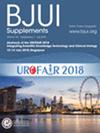用于自动肾结石分割的计算机视觉模型及其与外科医生的性能评估。
IF 4.4
2区 医学
Q1 UROLOGY & NEPHROLOGY
引用次数: 0
摘要
目的建立一种计算机视觉模型,对结石进行分割,以提高输尿管镜检查(URS)时的视觉效果,并将模型的性能与专家的性能进行比较。材料与方法收集肾内肾结石尿路治疗的影像136例。帧以每秒3帧(FPS)的速度提取并手工标注。视频数据集被分成训练子集(75%)、验证子集(5%)和测试子集(20%)。基于接收器-操作曲线下的面积、二元交叉熵损失和Dice相似系数(DSC),评估了模型在结石定位、激光消融和剩余碎片最终评估方面的性能。通过对逐帧分割精度的两两比较,将模型性能与五名获得委员会认证的泌尿科医生的手动注释进行比较。结果最终数据集包括来自38个光纤视频和98个数字视频的21718帧。总体而言,该模型表现出优异的性能:DSC为0.97(四分位间距[IQR] 0.91, 0.99),可以在30 FPS下进行分割。纤维镜(0.97 [IQR 0.91, 0.99])和数码镜(0.97 [IQR 0.92, 0.99])的表现相似。此外,该模型在结石定位(0.98 [IQR 0.93, 0.99])和结石激光消融(0.96 [IQR 0.89, 0.97])方面表现良好,在残留碎片评估(0.91 [IQR 0.50, 0.97])方面表现稍差。模型的表现与五位专家外科医生的总体表现相当。在一对一的比较中,该模型的表现明显优于五位专家中的三位,而与其他两位的表现相似。结论计算机视觉模型对URS中特定任务的结石分割评价具有较好的效果。该模型的分割性能与专家外科医生的分割性能相似,证明了其在术中实时应用的可行性。本文章由计算机程序翻译,如有差异,请以英文原文为准。
A computer vision model for automated kidney stone segmentation and evaluation of its performance vs surgeons.
OBJECTIVES
To develop a computer vision model that segments stones to improve visualisation during ureteroscopy (URS) and to compare model performance to that of experts.
MATERIALS AND METHODS
We collected 136 videos of URS for intrarenal kidney stone treatment. Frames were extracted at 3 frames per second (FPS) and manually annotated. The video dataset was split into training (75%), validation (5%) and testing (20%) subsets. Model performance was evaluated for stone localisation, laser ablation, and final evaluation of remaining fragments based on area under the receiver-operating curve, binary cross-entropy loss and Dice similarity coefficient (DSC). Model performance was compared to the manual annotations of five board-certified urologists through pairwise comparison of frame-by-frame segmentation accuracy.
RESULTS
The final dataset consisted of 21 718 frames from 38 fibreoptic and 98 digital videos. Overall, the model showed excellent performance: DSC 0.97 (interquartile range [IQR] 0.91, 0.99) and could segment at 30 FPS. Performance was similar for both fibreoptic (0.97 [IQR 0.91, 0.99]) and digital scopes (0.97 [IQR 0.92, 0.99]). Additionally, the model demonstrated good performance during stone localisation (0.98 [IQR 0.93, 0.99]) and stone laser ablation (0.96 [IQR 0.89, 0.97]), with slightly worse performance during evaluation of residual fragments (0.91 [IQR 0.50, 0.97]). Model performance was comparable to the five expert surgeons overall. In a head-to-head comparison, the model significantly outperformed three of the five experts and performed similarly to the other two.
CONCLUSION
The computer vision model demonstrates good performance for task-specific stone segmentation evaluation during URS. The segmentation performance of the model was similar to the segmentation performance of expert surgeons, demonstrating the feasibility of its real-time intra-operative utilisation.
求助全文
通过发布文献求助,成功后即可免费获取论文全文。
去求助
来源期刊

BJU International
医学-泌尿学与肾脏学
CiteScore
9.10
自引率
4.40%
发文量
262
审稿时长
1 months
期刊介绍:
BJUI is one of the most highly respected medical journals in the world, with a truly international range of published papers and appeal. Every issue gives invaluable practical information in the form of original articles, reviews, comments, surgical education articles, and translational science articles in the field of urology. BJUI employs topical sections, and is in full colour, making it easier to browse or search for something specific.
 求助内容:
求助内容: 应助结果提醒方式:
应助结果提醒方式:


